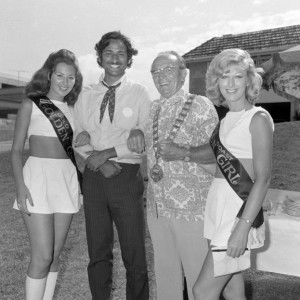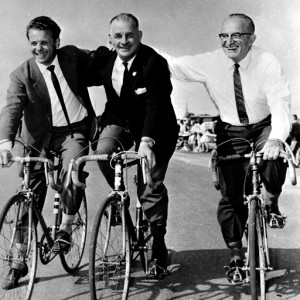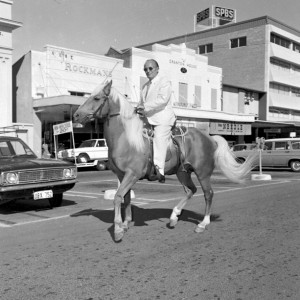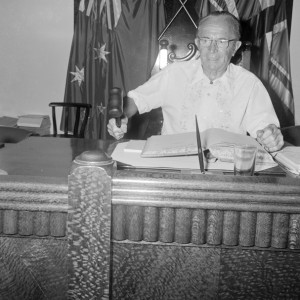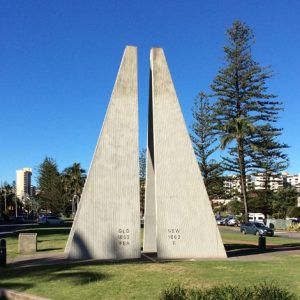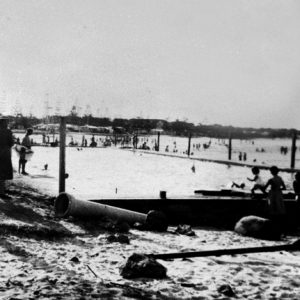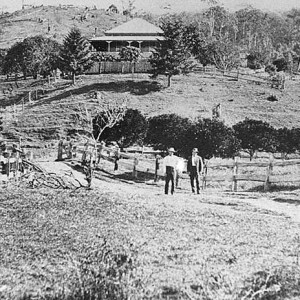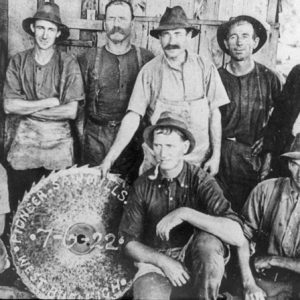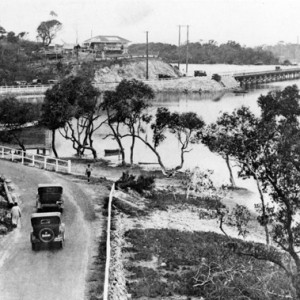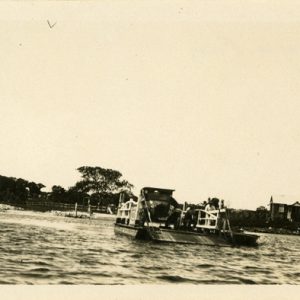
Born on 11 December 1895 at Ryde, Sydney, Andrew Bruce Small was the second child of William and Annie Small. His parents were members of the Salvation Army and by the age of six he was playing the tenor horn in Salvation Army bands.
Known as Bruce, he started working for a printer when he was 13 and later sold bike parts. In 1920 he borrowed money to purchase the Malvern Star bicycle shop belonging to one of his customers, Tom Finnigan. Over time, Malvern Star grew into the largest bike company in the southern hemisphere and became a household name in Australia. Bruce was also involved in radio and refrigeration but sold his existing business interests in 1958 and moved to the Gold Coast.
Despite intending to retire, upon his arrival to the Gold Coast, Bruce purchased land at MacIntosh Island intending to develop a residential estate. He subsequently sold the land and purchased 100 acres of land behind Surfers Paradise on the western side of the Nerang River.
- Mayor Bruce Small with Golden Girls and a tennis player, 1971. Photographer Bob Avery
- Reginald Arnold, Hubert Opperman and Bruce Small, Isle of Capri, 1965. Photographer Bob Avery
- Mayor Alderman Bruce Small riding a horse in Southport, 24 June 1972. Photographer Bob Avery
- Mayor Alderman Bruce Small with his gavel, March 1973. Photographer Bob Avery
His intention was to transform the land to residential housing lots with direct access to water, based on the canal developments of Florida in the USA. To offset the cost of constructing a bridge, he purchased an additional 500 acres. Bruce eventually developed 1500 acres of land as part of Paradise City which also included the Isle of Capri.
At the age of 71, Bruce decided to enter local politics and served as Mayor of the Gold Coast in 1967 – 1973, Alderman between 1973 – 76 and Mayor 1976-78. When he also became the State Member of Parliament for Surfers Paradise from 1974 – 1977 he became the second oldest person elected to the Queensland Parliament. He was knighted in 1974 for services to the Gold Coast and Queensland.
In addition to his land development, Bruce was interested in raising the profile of the Gold Coast. Following the floods and beach erosion that occurred in his first year of Mayor, tourist numbers had declined.
He focused on actively promoting the Gold Coast as a holiday destination with parades and tours both interstate and to New Zealand. Included as a feature in these promotional events were the Meter Maids, Golden Girls and Courtesy Maids, wearing their gold bikinis and Paula Stafford designs to reinforce the idea of the Gold Coast as a sub-tropical holiday destination offering fun and excitement.
In addition to his work as an elected representative, developer and promoter of the Gold Coast, it is believed he also encouraged Sir Joh Bjelke-Petersen to abolish death and gift duties in Queensland.
His funeral on 2 May 1980, attended by his wife, son, family and numerous elected representatives and dignitaries was the biggest funeral held at the Allambe Garden of Memories in Nerang.
A park is named in Bruce Small’s honour on the Isle of Capri and Sir Bruce Small Boulevard can be found in Benowa Waters. A bronze sculpture of Sir Bruce Small on Elkhorn Avenue, Surfers Paradise was unveiled by Sir Joh Bjelke- Pertersen on 3 October 1986.
Lady Small Haven Nursing Home at Ashmore is named after his second wife, Lady Lillian.
Sources of information and further reading
- Lunn, Hugh. “Thinking big is a Small secret of success.” The Australian, 8 May 1972.
- Gleeson, Peter. “Big Small mistake: Bruce’s treasure at dump.” The Gold Coast Bulletin, 3-4 Mar 2001, p. 3.
- Mossop, Brian. “Leader of the band.” The Gold Coast Bulletin, 14-15 Jun 1997.
- “Coast’s First Lady dies.” The Gold Coast Bulletin, 10 May 1991, p. 2.
Harvey, Jack. “Sir Bruce and Joh showed the way.” The Gold Coast Bulletin, 17 May 1983. - “A remarkable citizen: even his meter maids were there.” The Gold Coast Bulletin, 3 May 1980.
- Longhurst, Robert. Small, Sir Andrew Bruce (1895–1980). Australian Dictionary of Biography, National Centre of Biography, Australian National University.
- Waterson and Arnold. Biographical Register of the Queensland Parliament 1930- 1980. Canberra: A.N.U.P., 1982.
